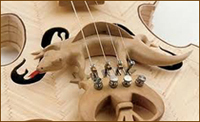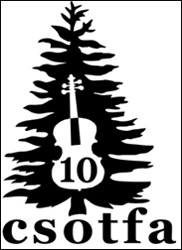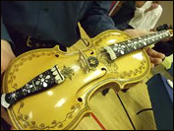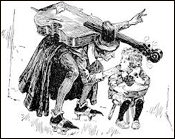

|
"To promote an interest in the old time American fiddle styles and to create more opportunities for interested parties to learn about the lineage of fiddle music in America, to promote activities related to old time fiddling (jams and concerts, and contests), to foster a sense of community in this shared musical treasure, and to preserve a truly American art form."
Sign our guest book and let us know you were here. |

|
District Representative: Tim Rued Board Members President: To Be Announced! Vice-President: Don Coffin Secretary: Judith Jones District Treasurer: Mike Drayton Membership Secretary: Judith Jones Advisory Council: Janette Duncan ~ Andi Skelton ~ John Clendenen Web Site admin: Chris Carney Meetings
~ Membership Form ~*The 43rd Cloverdale Old Time Fiddle festival*Check it out here for all the infomation!!!*Friends of the Festival form...*~ Sessions ~Ely Stage Stop9921 Soda Bay Rd. Kelseyville, CA 95451, about 1/2 mile from Hwy 29 on the left. Contact: Don Coffin at:drcoffin@att.net 707-995-0658 or Andi Skeltonskeltonmusic@jps.net 707-279-4336 Church of the Oaks 175 Page St, Cotati, CA 94931 Contact:Janette Duncan or Chris Carney for more info. Murphy's Irish Pub 464 First Street, Sonoma Aqus Cafe 189 H Street, Petaluma Sebastopol Grange (one half mile east of Morris Street on Highway 12, east of Sebastopol, next to Weeks Drilling) 6000 Sebastopol Ave, Sebastopol ~Other Stuff~ 
CSOTFA10 PICS...~State and other district links:~
Things to do...*December 9th, Saturday, Old-time jam- Rotary Valley Senior Village Community Center San Rafael, 11:00am -1:00pm. Pat Palmer 415-305-4250 everevolving@earthlink.com *December 9th, Saturday, The Bloomfield Bluegrass Band 3:00-6:00pm, Alley 6 Distillery Healdsburg *December 14th, Thursday, West of Malarkey -Sebastopol Senior Center holiday luncheon 11:00-1:00 *December 14th, Thursday, Taylor Mountain String Band at The Redwood Cafe 6-8pm *December 16th, Saturday, Old-time jam, slow 1-2 pm, up-tempo 2-4:30 pm. 42 Charles St. (clubhouse) Cotati. Heidi Chesney 510-846-7642. heidichesney@gmail.com *December 16th, Saturday, The Crooked Holler String Band at The Redwood Cafe 6-8pm *December 17th, Sunday, Old-Time jam 1pm-3:30pm, Way Station, 2001 Sir Francis Drake Blvd., Fairfax. BBQ & beer, outdoor patio. Bring your instrument, a chair, wear layers, sunscreen. Dinah Stroe dinahbeatrice@gmail *December 21st, Thursday, Bloomfield Bluegrass Band 7:00pm WillowBrook Ale House, Petaluma *December 28th, Thursday, Bloomfield Bluegrass Band 7:00pm WillowBrook Ale House, Petaluma *December 31st, Sonoma County Folk Society's NEW YEARS EVE- 5th Sunday- jamming,potluck,open mic, 4:00pm- 10:00pm. Contact Janette Duncan janettefiddler@gmail.com or 707-483-6885 to coordinate your potluck dish. Email |
The Delmore Brothers Alton Delmore (December 25, 1908 - June 9, 1964) and Rabon Delmore (December 3, 1916 - December 4, 1952) billed as The Delmore Brothers, were country music pioneer singer-songwriters and musicians who were stars of the Grand Ole Opry in the 1930s. The Delmore Brothers, together with other brother duos such as the Louvin Brothers, The Blue Sky Boys, the Monroe Brothers (Birch Monroe, Charlie Monroe and Bill Monroe), the McGee Brothers, and The Stanley Brothers, had a profound impact on the history of country music and American popular music. The duo performed extensively with old time fiddler Arthur Smith as the Arthur Smith Trio throughout the 1930s.
Biography
Alton Delmore (December 25, 1908 - June 9, 1964) and Rabon Delmore (December 3, 1916 - December 4, 1952) billed as The Delmore Brothers, were country music pioneer singer-songwriters and musicians who were stars of the Grand Ole Opry in the 1930s. The Delmore Brothers, together with other brother duos such as the Louvin Brothers, The Blue Sky Boys, the Monroe Brothers (Birch Monroe, Charlie Monroe and Bill Monroe), the McGee Brothers, and The Stanley Brothers, had a profound impact on the history of country music and American popular music. The duo performed extensively with old time fiddler Arthur Smith as the Arthur Smith Trio throughout the 1930s.
Biography
 The brothers were born into poverty in Elkmont, Alabama, United States, as the sons of tenant farmers amid a rich tradition of gospel music and Appalachian folk. Their mother, Mollie Delmore, wrote and sang gospel songs for their church. The Delmores blended gospel-style harmonies with the quicker guitar work of traditional folk music and the blues to help create the still-emerging genre of country. In addition to the regular six-string acoustic guitar, the duo was one of the few to use the rare tenor guitar, a four-string instrument that had primarily been used previously in vaudeville shows.
The brothers were born into poverty in Elkmont, Alabama, United States, as the sons of tenant farmers amid a rich tradition of gospel music and Appalachian folk. Their mother, Mollie Delmore, wrote and sang gospel songs for their church. The Delmores blended gospel-style harmonies with the quicker guitar work of traditional folk music and the blues to help create the still-emerging genre of country. In addition to the regular six-string acoustic guitar, the duo was one of the few to use the rare tenor guitar, a four-string instrument that had primarily been used previously in vaudeville shows.
 In 1925, 16-year-old Alton wrote his first song ("Bound for the Shore"), which he co-wrote with his mother. It was published by Athens Music Co.
In 1930, the brothers entered a contest in Athens, Alabama and won first prize after almost being beaten by a comedy act in multiple rounds of tie breakers.
In 1925, 16-year-old Alton wrote his first song ("Bound for the Shore"), which he co-wrote with his mother. It was published by Athens Music Co.
In 1930, the brothers entered a contest in Athens, Alabama and won first prize after almost being beaten by a comedy act in multiple rounds of tie breakers.
 The Brothers did their first recording session for Columbia Records in 1931, recording "Got The Kansas City Blues" and "Alabama Lullaby," which became their theme song. They signed a contract with Victor's budget label Bluebird in 1933 and became regulars on the Grand Ole Opry. Within three years, they had become the most popular act on the show.
In 1934, Arthur Smith (later known as "Fiddlin' Arthur Smith" to distinguish him from Arthur "Guitar Boogie" Smith) began touring with The Delmore Brothers. The trio recorded together for the next three years and had played together on over 52 sides together under both The Delmore Brothers and The Arthur Smith Trio. Their first session together was in 1935 for Bluebird. Talent scouts were impressed with Arthur's playing and recorded his first sides with Alton and Rabon backing him up. During a recording session in 1937 for Bluebird, Alton had a cold forcing him to sing lower which ended up damaging his vocal chords. After this, Alton was not able to sing as high ever again.
Disagreements with Opry management led to the brothers leaving the show in 1938. After leaving the Opry, the brothers moved to WPTF in Raleigh, North Carolina. While they continued to play and record music throughout the 1940s, they never achieved the same level of success they had with the Grand Ole Opry.
The Brothers did their first recording session for Columbia Records in 1931, recording "Got The Kansas City Blues" and "Alabama Lullaby," which became their theme song. They signed a contract with Victor's budget label Bluebird in 1933 and became regulars on the Grand Ole Opry. Within three years, they had become the most popular act on the show.
In 1934, Arthur Smith (later known as "Fiddlin' Arthur Smith" to distinguish him from Arthur "Guitar Boogie" Smith) began touring with The Delmore Brothers. The trio recorded together for the next three years and had played together on over 52 sides together under both The Delmore Brothers and The Arthur Smith Trio. Their first session together was in 1935 for Bluebird. Talent scouts were impressed with Arthur's playing and recorded his first sides with Alton and Rabon backing him up. During a recording session in 1937 for Bluebird, Alton had a cold forcing him to sing lower which ended up damaging his vocal chords. After this, Alton was not able to sing as high ever again.
Disagreements with Opry management led to the brothers leaving the show in 1938. After leaving the Opry, the brothers moved to WPTF in Raleigh, North Carolina. While they continued to play and record music throughout the 1940s, they never achieved the same level of success they had with the Grand Ole Opry.
 In 1941, their song "When It's Time for the Whippoorwill to Sing" made the Billboard "Hillbilly" top three.
In 1942, the brothers were officially signed to King Records. However, many of the early King Records that predate this signing were released under pen names. "Someday You'll Pay," "Remember I Feel Lonesome, Too," "Going Back to the Blueridge Mountains," and "The Last Old Shovel" were released under Alton's Pseudonym "Jim Scott".
In 1941, their song "When It's Time for the Whippoorwill to Sing" made the Billboard "Hillbilly" top three.
In 1942, the brothers were officially signed to King Records. However, many of the early King Records that predate this signing were released under pen names. "Someday You'll Pay," "Remember I Feel Lonesome, Too," "Going Back to the Blueridge Mountains," and "The Last Old Shovel" were released under Alton's Pseudonym "Jim Scott".
 While a myth exists stating that all of the King sides were recorded in Cincinnati, this is untrue. The sides were recorded wherever the Delmores were living at the time. The brothers tended to move two to three times a year which meant there were a lot of places that were sites of the recordings. The sides were recorded in Indianapolis, Memphis, Chattanooga, Jackson, Mississippi, Athens, Alabama, Covington, Fort Smith, Del Rio, and Houston.
While a myth exists stating that all of the King sides were recorded in Cincinnati, this is untrue. The sides were recorded wherever the Delmores were living at the time. The brothers tended to move two to three times a year which meant there were a lot of places that were sites of the recordings. The sides were recorded in Indianapolis, Memphis, Chattanooga, Jackson, Mississippi, Athens, Alabama, Covington, Fort Smith, Del Rio, and Houston.
 Their "Freight Train Boogie" (recorded for the King label in 1946) is regarded by some as the first rock and roll record. Their best-known song, "Blues Stay Away From Me" (also on King, 1949), was covered by Johnny Burnette and The Rock and Roll Trio, Gene Vincent and the Blue Caps, The Louvin Brothers, The Browns, Les Paul and Mary Ford, Doc Watson, The Notting Hillbillies, Marshall Chapman, and The Everly Brothers.
Over the course of their careers, the Delmores wrote more than one thousand songs. Some of the most popular were "Brown's Ferry Blues," "Gonna Lay Down My Old Guitar" and "Fifteen Miles from Birmingham." Their guitar-based recordings were key in establishing the guitar as central in country and, later, rockabilly and rock and roll. A third instrument featured in many of their postwar records is the harmonica of Wayne Raney.
Rabon died of lung cancer in 1952, a day after his 36th birthday. Following Rabon's death, Alton suffered a heart attack, the loss of his father and his daughter Susan, all within a three-year period. He moved back to Huntsville, Alabama. He taught some guitar, did odd jobs, and devoted his creative energies to writing prose. He wrote a series of short stories and his autobiography, "Truth is Stranger than Publicity", published posthumously in 1977 by the Country Music Foundation.
Legacy.
Their "Freight Train Boogie" (recorded for the King label in 1946) is regarded by some as the first rock and roll record. Their best-known song, "Blues Stay Away From Me" (also on King, 1949), was covered by Johnny Burnette and The Rock and Roll Trio, Gene Vincent and the Blue Caps, The Louvin Brothers, The Browns, Les Paul and Mary Ford, Doc Watson, The Notting Hillbillies, Marshall Chapman, and The Everly Brothers.
Over the course of their careers, the Delmores wrote more than one thousand songs. Some of the most popular were "Brown's Ferry Blues," "Gonna Lay Down My Old Guitar" and "Fifteen Miles from Birmingham." Their guitar-based recordings were key in establishing the guitar as central in country and, later, rockabilly and rock and roll. A third instrument featured in many of their postwar records is the harmonica of Wayne Raney.
Rabon died of lung cancer in 1952, a day after his 36th birthday. Following Rabon's death, Alton suffered a heart attack, the loss of his father and his daughter Susan, all within a three-year period. He moved back to Huntsville, Alabama. He taught some guitar, did odd jobs, and devoted his creative energies to writing prose. He wrote a series of short stories and his autobiography, "Truth is Stranger than Publicity", published posthumously in 1977 by the Country Music Foundation.
Legacy.
 The Delmore Brothers were inducted into the Nashville Songwriters Hall of Fame in October 1971, as well as the Alabama Music Hall of Fame in 1989 and the Country Music Hall of Fame in 2001. Their pioneering contribution to the genre has been recognized by the Rockabilly Hall of Fame.
The Brother's later records with electric guitars and boogie beat landed them a spot on the Rolling Stone's History of Rock n' Roll!
Bob Dylan was quoted in the Chicago Tribune, on November 10, 1985 as saying, "The Delmore Brothers, God, I really loved them! I think they've influenced every harmony I've ever tried to sing."
The Delmore Brothers were inducted into the Nashville Songwriters Hall of Fame in October 1971, as well as the Alabama Music Hall of Fame in 1989 and the Country Music Hall of Fame in 2001. Their pioneering contribution to the genre has been recognized by the Rockabilly Hall of Fame.
The Brother's later records with electric guitars and boogie beat landed them a spot on the Rolling Stone's History of Rock n' Roll!
Bob Dylan was quoted in the Chicago Tribune, on November 10, 1985 as saying, "The Delmore Brothers, God, I really loved them! I think they've influenced every harmony I've ever tried to sing."
 The Brothers recorded over 200 sides with major labels as the Delmore Brothers, and many more under pseudonyms such as Alton's most famous persona, "Jim Scott". Alton wrote many songs that were never released.
Partial discography:
The Brothers recorded over 200 sides with major labels as the Delmore Brothers, and many more under pseudonyms such as Alton's most famous persona, "Jim Scott". Alton wrote many songs that were never released.
Partial discography:
Albums Sacred Songs (King, 1957) In Memory (King, 1964) In Memory, Vol. 2 (King, 1964) Wonderful Sacred Songs (King, 1966) When They Let The Hammer Fall (Bear Family, 1984) Lonesome Yodel Blues (Old Homestead, 1985) Classic Cuts: 1933-1941 (JSP, 2003) Fifty Miles To Travel (Ace, 2005) The Delmore Brothers, Vol. 2: The Later Years 1933-1952 (JSP, 2007) Blues Stay Away From Me (Jasmine, 2008) Classic Cuts, Vol. 3: More From The 1930s Plus (JSP, 2008) The Delmore Brothers ---------------------------------------------------------------------------------------------------- Here are the: ~Approved By-Laws~Click here for the pdf file Cloverdale Fiddle Festival Results 2015Cloverdale Fiddle Festival Results 2017Cloverdale Fiddle Festival Results 2018CBA Bluegrass Breakdown! |
Any comments or questions about the web site, please send email to: csotfa10@yahoo.com